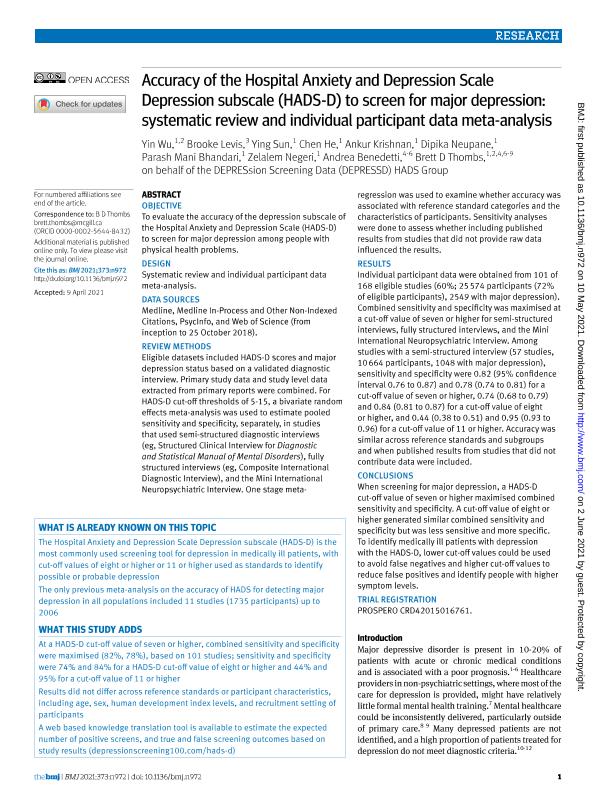Mostrar el registro sencillo del ítem
dc.contributor.author
Wu, Yin
dc.contributor.author
Levis, Brooke
dc.contributor.author
Sun, Ying
dc.contributor.author
He, Chen
dc.contributor.author
Krishnan, Ankur
dc.contributor.author
Neupane, Dipika
dc.contributor.author
Bhandari, Parash Mani
dc.contributor.author
Negeri, Zelalem
dc.contributor.author
Benedetti, Andrea
dc.contributor.author
Thombs, Brett D.
dc.contributor.author
Daray, Federico Manuel

dc.date.available
2021-12-07T13:50:43Z
dc.date.issued
2021-05
dc.identifier.citation
Wu, Yin; Levis, Brooke; Sun, Ying; He, Chen; Krishnan, Ankur; et al.; Accuracy of the Hospital Anxiety and Depression Scale Depression subscale (HADS-D) to screen for major depression: Systematic review and individual participant data meta-analysis; BMJ Publishing Group; The BMJ; 373; 5-2021; 1-12
dc.identifier.issn
1756-1833
dc.identifier.uri
http://hdl.handle.net/11336/148371
dc.description.abstract
Objective To evaluate the accuracy of the depression subscale of the Hospital Anxiety and Depression Scale (HADS-D) to screen for major depression among people with physical health problems. Design Systematic review and individual participant data meta-analysis. Data sources Medline, Medline In-Process and Other Non-Indexed Citations, PsycInfo, and Web of Science (from inception to 25 October 2018). Review methods Eligible datasets included HADS-D scores and major depression status based on a validated diagnostic interview. Primary study data and study level data extracted from primary reports were combined. For HADS-D cut-off thresholds of 5-15, a bivariate random effects meta-analysis was used to estimate pooled sensitivity and specificity, separately, in studies that used semi-structured diagnostic interviews (eg, Structured Clinical Interview for Diagnostic and Statistical Manual of Mental Disorders), fully structured interviews (eg, Composite International Diagnostic Interview), and the Mini International Neuropsychiatric Interview. One stage meta-regression was used to examine whether accuracy was associated with reference standard categories and the characteristics of participants. Sensitivity analyses were done to assess whether including published results from studies that did not provide raw data influenced the results. Results Individual participant data were obtained from 101 of 168 eligible studies (60%; 25 574 participants (72% of eligible participants), 2549 with major depression). Combined sensitivity and specificity was maximised at a cut-off value of seven or higher for semi-structured interviews, fully structured interviews, and the Mini International Neuropsychiatric Interview. Among studies with a semi-structured interview (57 studies, 10 664 participants, 1048 with major depression), sensitivity and specificity were 0.82 (95% confidence interval 0.76 to 0.87) and 0.78 (0.74 to 0.81) for a cut-off value of seven or higher, 0.74 (0.68 to 0.79) and 0.84 (0.81 to 0.87) for a cut-off value of eight or higher, and 0.44 (0.38 to 0.51) and 0.95 (0.93 to 0.96) for a cut-off value of 11 or higher. Accuracy was similar across reference standards and subgroups and when published results from studies that did not contribute data were included. Conclusions When screening for major depression, a HADS-D cut-off value of seven or higher maximised combined sensitivity and specificity. A cut-off value of eight or higher generated similar combined sensitivity and specificity but was less sensitive and more specific. To identify medically ill patients with depression with the HADS-D, lower cut-off values could be used to avoid false negatives and higher cut-off values to reduce false positives and identify people with higher symptom levels.
dc.format
application/pdf
dc.language.iso
eng
dc.publisher
BMJ Publishing Group
dc.rights
info:eu-repo/semantics/openAccess
dc.rights.uri
https://creativecommons.org/licenses/by-nc-sa/2.5/ar/
dc.subject
HADS-D
dc.subject.classification
Psiquiatría

dc.subject.classification
Medicina Clínica

dc.subject.classification
CIENCIAS MÉDICAS Y DE LA SALUD

dc.title
Accuracy of the Hospital Anxiety and Depression Scale Depression subscale (HADS-D) to screen for major depression: Systematic review and individual participant data meta-analysis
dc.type
info:eu-repo/semantics/article
dc.type
info:ar-repo/semantics/artículo
dc.type
info:eu-repo/semantics/publishedVersion
dc.date.updated
2021-12-03T20:41:28Z
dc.journal.volume
373
dc.journal.pagination
1-12
dc.journal.pais
Reino Unido

dc.description.fil
Fil: Wu, Yin. School Of Medicine; Canadá. Lady Davis Institute For Medical Research; Canadá
dc.description.fil
Fil: Levis, Brooke. Keele University; Reino Unido
dc.description.fil
Fil: Sun, Ying. Lady Davis Institute For Medical Research; Canadá
dc.description.fil
Fil: He, Chen. Lady Davis Institute For Medical Research; Canadá
dc.description.fil
Fil: Krishnan, Ankur. Lady Davis Institute For Medical Research; Canadá
dc.description.fil
Fil: Neupane, Dipika. Lady Davis Institute For Medical Research; Canadá
dc.description.fil
Fil: Bhandari, Parash Mani. Lady Davis Institute For Medical Research; Canadá
dc.description.fil
Fil: Negeri, Zelalem. Université Mcgill; Canadá. Lady Davis Institute For Medical Research; Canadá
dc.description.fil
Fil: Benedetti, Andrea. Centre Universitaire de Santé Mcgill; Canadá
dc.description.fil
Fil: Thombs, Brett D.. Mcgill Faculty Of Medicine And Health Sciences; Canadá. Lady Davis Institute For Medical Research; Canadá
dc.description.fil
Fil: Daray, Federico Manuel. Universidad de Buenos Aires. Facultad de Medicina. Instituto de Farmacologia; Argentina. Consejo Nacional de Investigaciones Científicas y Técnicas. Oficina de Coordinación Administrativa Houssay; Argentina
dc.journal.title
The BMJ
dc.relation.alternativeid
info:eu-repo/semantics/altIdentifier/doi/http://dx.doi.org/10.1136/bmj.n972
dc.relation.alternativeid
info:eu-repo/semantics/altIdentifier/url/https://www.bmj.com/content/373/bmj.n972
Archivos asociados
